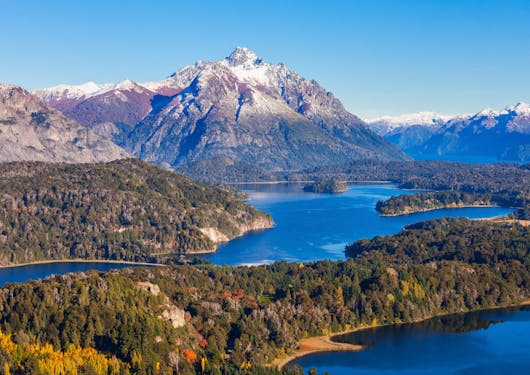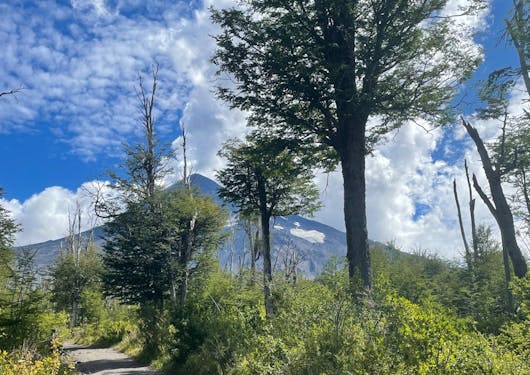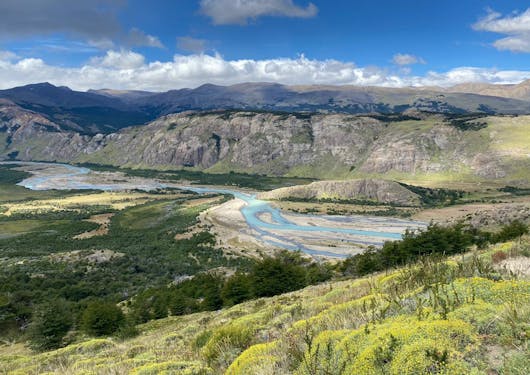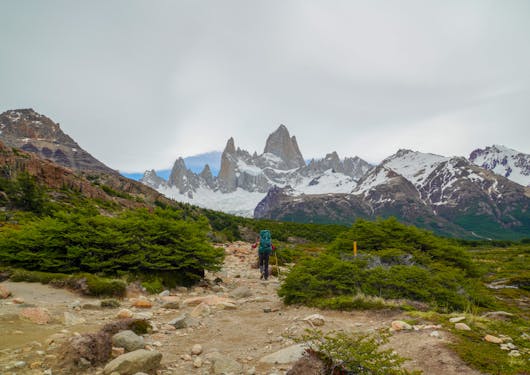Duration
Argentine Patagonia for Adventure Lovers
From $6,890
Bookable From
October - April
Trip Style
Privately Guided
Country
Argentina
Physical Rating
Mildly Strenuous
Overview
Slow-travel through Argentine Patagonia as you hike, bike, and trek through awe-inspiring nature.
Embark on an unforgettable journey through Argentina’s wild and beautiful Patagonia. From the vibrant streets of Buenos Aires to the majestic mountains of Patagonia, this adventure is made for adventure lovers and outdoor enthusiasts.
Start with a bike ride through the charming neighborhoods of Buenos Aires before flying to San Martín de los Andes, a peaceful mountain town nestled in the Andes. Explore the beauty of Lanín Volcano, cycle along serene lagoons, and enjoy the iconic Seven Lakes Route to Bariloche. Discover Bariloche’s alpine charm and panoramic trails before continuing south to El Calafate, home to the inspiring Perito Moreno Glacier.
Then, travel to El Chaltén, Argentina’s hiking capital. Walk the legendary trails to Cerro Torre and Laguna de los Tres, surrounded by glaciers and mountain peaks. Return to Buenos Aires for a night of tango and time to relax before heading home.
Highlights
- Cycle through Buenos Aires' elegant northern neighborhoods, discovering local life, leafy parks, and grand architecture on two wheels.
- Trek to the base of the iconic Lanín Volcano, surrounded by ancient forests and snow-dusted peaks in Patagonia’s serene Lake District.
- Journey along the legendary Route of the Seven Lakes, a breathtaking drive through mirror-like lakes and mountain vistas between San Martín and Bariloche.
- Walk on the mighty Perito Moreno Glacier, feeling the crunch of ancient ice beneath your feet during an unforgettable trekking adventure.
- Experience a passionate tango performance over a traditional Argentine dinner, the perfect finale to your journey through nature and culture.








Itinerary Overview
Day 1: Buenos Aires – Arrival – Northern Bike Tour
Day 2: Buenos Aires – San Martín de los Andes – Afternoon at Leisure
Day 3: San Martín de Los Andes- Full Day Trekking to Lanín Volcano
Day 4: San Martín de los Andes – Half Day Biking at Rosales Lagoon
Day 5: San Martín de los Andes - Bariloche – Scenic Drive through the 7 Lakes
Day 6: Bariloche – Half Day City Circuit Hike
Day 7: Bariloche – Bariloche - El Calafate - Afternoon at Leisure
Day 8: El Calafate – Full Day Trekking at Perito Moreno Glacier
Day 9: El Calafate- Full Day Visit to an Emblematic and Traditional Estancia
Day 10: El Calafate - El Chaltén – Afternoon at Leisure
Day 11: El Chaltén – Full Day Hiking Cerro Torre
Day 12: El Chaltén - Full Day Hiking De los Tres Lagoon
Day 13: El Chaltén - Buenos Aires – Dinner Tango Show
Day 14: Buenos Aires – Day at Leisure
Day 15: Buenos Aires - Departure
Seasonal Notes
🔺 High Season (mid-December to February)
This is summer in Argentina — the warmest time of the year, with long days and lively energy across all destinations.
Buenos Aires is vibrant and summery this time of year — hot and humid, yes, but with a lively energy. During January and part of February, many locals head out on holiday, and the city takes on a calmer pace, giving visitors the chance to enjoy its cafés, museums, and leafy streets with more space to breathe and fewer crowds around.
In Northern Patagonia (Bariloche & San Martín de los Andes), conditions are ideal for outdoor adventures. Lakes shimmer under the sun, trails are open for hiking, and the scenic roads reveal through mountain landscapes. This is the peak season for enjoying the region’s natural beauty, with pleasant temperatures and plenty of activity on and off the water.
Further south, in El Calafate and El Chaltén, summer brings extended daylight and relatively mild weather — perfect for glacier excursions, trekking, and exploring Patagonia’s dramatic terrain. Trails are more accessible, and the landscapes are striking in the bright summer light.
Perfect for travelers who enjoy a lively atmosphere — when Argentina is at its most active, with popular spots buzzing, long sunny days, and a festive summer spirit. Expect more visitors and crowds, and more energy and movement everywhere.
🔷 Mid / Shoulder Season (October to mid-December & March to April)
Shoulder season in Argentina is a favorite for many travelers, thanks to its mild weather, thinner crowds, and beautifully changing landscapes.
In Buenos Aires, the city is at its most pleasant. Whether it’s spring (October–December) or autumn (March–April), temperatures are comfortable, perfect for walking tours, cultural outings, and slow afternoons in leafy parks or café-lined streets.
In Northern Patagonia (Bariloche & San Martín de los Andes), nature puts on a show: either with spring blooms and fresh greenery or the golden tones of fall foliage. It’s an ideal time for hiking, scenic drives, and enjoying the lakes with fewer people around and a slower, more serene pace.
In El Calafate and El Chaltén, the landscapes are stunning. Trails are open, the air is fresh, and the views are as dramatic as ever. Most excursions are still operating during these months, though a few may be winding down or just starting up, depending on the timing. It can be a little bit colder and windy, but the trails are still open.
Perfect for travelers who enjoy a balance of good weather and less crowded destinations and are okay with a little bit cooler temperatures.
*Try to avoid Easter holidays if possible — if you’re thinking of traveling in March or April, be sure to check the Easter holiday dates, as they vary annually.
🔻 Low Season (May to September)
Low season in Argentina isn’t the most popular time to visit — but it holds its own charm, with peaceful landscapes, fewer crowds, and a more relaxed rhythm in each destination.
In Buenos Aires, the city remains active and enjoyable, offering cultural events, vibrant neighborhoods, cozy cafés, and excellent dining — all with fewer tourists around. The cooler weather brings a slower, more local vibe that many travelers appreciate.
In Northern Patagonia (Bariloche & San Martín de los Andes), winter (June to August) paints the mountains white and turns the region into Argentina’s main ski destination. Snow lovers will enjoy skiing, while others enjoy a completely different take on the Lake District — quiet, scenic, and covered in frost. It’s a magical setting, perfect for a winter retreat.
Further south, in El Calafate and El Chaltén, the landscapes remain striking, though daylight hours are shorter and some excursions — like the famous Mini Trekking and Big Ice — pause between early June and mid-July. Still, the Perito Moreno Glacier is open year-round, and the quieter atmosphere can make for a uniquely peaceful experience in Patagonia.
Perfect for travelers who enjoy slower moments, crisp air, and don’t mind colder temperatures. While some activities may be limited and the weather cooler, this season offers space, calm, and a different — often deeper — way to experience Argentina.
*Avoid the Argentine winter school holidays in July if you’re looking for a quieter experience. Check on these dates, as they vary annually.
Itinerary
Day 1 Arrival at Buenos Aires & Bike City Tour
Day 2 From Buenos Aires to San Martin de los Andes
Day 3 San Martin de los Andes - Full-day Trekking to Lanin Volcano Base
Day 4 San Martin de los Andes - Half-day Biking at Rosales Lagooon
Day 5 San Martin de los Andes to Bariloche - Scenic Drive
Day 6 Bariloche - Half-day Short Circuit Trekking
Day 7 Bariloche to El Calafate - Leisure day
Day 8 El Calafate - Full day Trekking at Perito Moreno Glacier
Day 9 El Calafate - Full-day Visit to a Traditional Patagonian Estancia
Day 10 El Calafate to El Chaltén - Day at leisure
Day 11 El Chaltén - Full-day Hiking to Cerro Torre
Day 12 El Chaltén - Full-day Trekking to Laguna de los Tres
Day 13 El Chaltén to Buenos Aires & Dinner Tango Show
Day 14 Buenos Aires - Day at Leisure
Day 15 Departure from Buenos Aires
Route Map

Inclusions & Exclusions
All arrival and departure transfers in each destination
Bilingual host included at the first arrival transfer
Bilingual guide for all excursions
3 nights of accommodation in Buenos Aires with breakfast
3 nights of accommodation at a boutique hotel in San Martín de los Andes with breakfast
2 nights in Bariloche with breakfast
3 nights in El Calafate at a boutique hotel with breakfast
3 nights in El Chaltén at a boutique hotel with breakfast
Half-day Bike City Tour in Buenos Aires (private)
Full-day Trekking to the base of the Lanin Volcano (private)
Half-day Biking Tour at Rosales Lagoon (private)
Full-day Scenic Drive from San Martín de los Andes to Bariloche through 7 lakes (private)
Half-day Hiking Circuit Tour (private)
Full-day Perito Moreno Glacier Visit with short Ice hike (Mini Trekking) (shared)
Full-day Visit to a Patagonian Estancia (shared)
Full-day Hiking to Cerro Torre (private)
Full-day Hiking to De los Tres Lagoon (private)
Dinner Tango Show in Buenos Aires + 30-minute dance lesson (shared)
14 buffet breakfasts
5 box lunches with a soft drink
1 lunch
1 three-course dinner with soft drinks at the Dinner Tango Show
24/7 emergency contact
Detailed welcome letter with travel information, destination notes, and all times schedules
Transportation & Guides
Accommodation
Activities & Experiences
Meals
Additional Services
International and domestic airfare
Services and meals not mentioned in the itinerary
Early check-in, late check-out, and other hotel extras
Personal expenses
Tips for guides and hotel staff
Visa fees or travel documentation
Travel insurance
Pricing
Prices exclude flights to/from the destination.
Prices are for double room occupancy unless indicated otherwise.
The pricing applies to the land portion of the trip. Internal flights can be quoted and booked upon request. To issue the tickets as soon as the itinerary is confirmed, airfare must be paid in full along with the deposit, unless you prefer to wait and book the flights at a later time.
Contact us for pricing for groups larger than 10.
Deposit per person
30% of the trip price
Shared Room - sleeps 2 - price per person
3* Hotels: $6,890 4* Hotels: $7,790
Payment & Cancellation Policy
This trip is offered from October through April.
At checkout, choose your preferred departure date and pay the deposit. Yugen Earthside’s standard Payment & Cancellation Policy applies.
Book With Confidence
- Your deposit is fully refundable for 30 days when you book 120+ days in advance and pay by bank transfer.
- If you pay by credit card, the card processing fees are non-refundable.
- We’ll confirm availability for your chosen dates within 3 business days. If confirmed, you’re all set! If not, we’ll help you adjust your dates or refund your deposit.
Sustainability
♻️ Our Philosophy and Commitment to Sustainability
We believe that travel should enrich both the traveler and the destination. Our itinerary is thoughtfully designed to immerse guests in Northern Argentina’s natural wonders while honoring and protecting the unique ecosystems and cultures that make this region so extraordinary. We aim to collaborate with local communities, support conservation efforts, and strive to work with suppliers who share our commitment to responsible tourism, always seeking a balance between quality experiences and positive impact.
🌳 Environmental Initiatives
While some destinations in this itinerary face challenges in implementing sustainable practices or are already heavily visited, we seek to strike a balance between must-see attractions and quality experiences whenever possible. We design our routes and activity flow to reduce pressure on sensitive areas, avoid peak hours, and promote lesser-visited trails or alternatives where appropriate.
All outdoor activities are conducted under Leave No Trace principles, emphasizing respect for the natural environment, responsible waste management, and low-impact travel. We brief travelers on how to minimize their footprint — from staying on marked paths to avoiding single-use plastics during excursions.
In national parks such as Lanín, Nahuel Huapi, and Los Glaciares, we work with certified guides who are trained in conservation practices and provide valuable context about local ecosystems. By integrating education into the travel experience, we help foster a deeper appreciation of the region’s biodiversity and environmental challenges.
While not every aspect of the journey can be sustainable due to logistical limitations in remote areas, we are committed to making conscious choices wherever possible — and to continually improving the environmental responsibility of our trips over time.
🛌 Accommodation Initiatives:
Each accommodation has been chosen not only for its quality and comfort but also for its environmental and social values. Whenever possible, we prioritize responsible hotels—those that are locally owned or that demonstrate a clear commitment to sustainability and community engagement. However, in some destinations, options that meet both our standards of quality and responsibility are limited. In those cases, we aim for a thoughtful balance, combining responsible properties with others that may not be fully sustainable but still offer excellent service and comfort. We always strive to ensure that, at the very least, they incorporate some form of social or environmental practice or support the local economy in meaningful ways.
Please note that accommodation is subject to availability. While we always try to secure our preferred responsible options, it may not always be possible. In such cases, we select the best available alternatives, keeping in mind the overall quality of the experience.
In Buenos Aires, our selected 3-star hotel incorporates sustainable materials and green architecture to ensure a comfortable, environmentally responsible stay. The 4-star property also emphasizes waste and water reduction and actively promotes local culture.
In Bariloche, selected hotels work closely with the local community and apply eco-friendly practices, including energy efficiency and waste reduction. In El Calafate, our preferred hotels include a 3* property that prioritizes sustainable water and energy use, and a boutique 4* hotel that incorporates local materials and crafts while supporting regional artisans and producers.
In San Martín de los Andes, we’ve selected for our Superior and Classic options a charming boutique property set in a tranquil natural setting just outside the town. While it hasn’t achieved formal sustainability certification, the property is locally owned and family managed, their sources are supplied locally, supports regional producers, and maintains a respectful stance toward the surrounding landscape.
Finally, in El Chaltén, our selected 3-star hotel holds the Gold-level “Hoteles Más Verdes” certification, operates under a zero‑waste policy, and has installed solar panels covering around one‑third of its energy needs. Their integrated environmental management system and innovative waste‑reduction initiatives mark a real dedication to responsible tourism. Also, our selected 4-star hotel has implemented multiple sustainable practices—like replacing single-use plastics, using biodegradable amenities, separating waste streams, employing LED lighting, and offering water refill stations—demonstrating a commitment to reducing its ecological footprint.
🤝 Social Initiatives
This itinerary aims to foster respectful connections with the people and cultures of Patagonia, valuing local knowledge and supporting community-driven efforts in tourism.
In Bariloche and San Martín de los Andes, we collaborate with locally based guides, small providers, and independent producers, helping to strengthen the local economy and promote cultural identity through everyday experiences. Our visits often include stops at regional artisan shops and family-owned establishments that reflect the character of each place.
At Estancia Cristina, travelers engage directly with long-time residents of the area and learn about the cultural and historical legacy of early Patagonian settlers. This experience helps preserve rural traditions while supporting small-scale, locally rooted tourism.
In El Chaltén, many of our partners are part of small cooperatives or family projects that have grown alongside the region’s development as a trekking destination. By choosing locally run services, we help support year-round employment and community-based initiatives tied to sustainable tourism.
Whenever possible, we prioritize experiences that create opportunities for cultural exchange and authentic encounters, while remaining mindful of the impact our presence can have on remote destinations.
💼 Economic Initiatives
We are committed to strengthening the local economy by partnering with family-run businesses, boutique accommodations, and small businesses, ensuring tourism revenue stays within the community to support long-term development.
The trip includes visits to independent producers and family-run operations like Estancia Cristina, where guests learn directly from local stewards of Patagonian land and culture.
✔️ Travel Flow Redistribution: We encourage traveling during shoulder and mid-seasons (October to mid-December and March to April) to avoid peak season concentration, distributing tourism income more evenly throughout the year, reducing overcrowding, and enabling smoother travel experiences with better rates.
Health & Safety
Be sure you have traveler's insurance.



